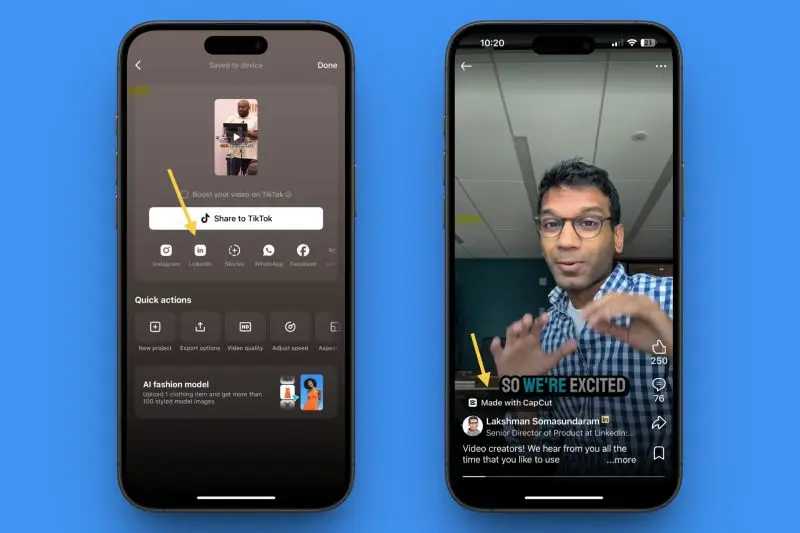- CapCut’s LinkedIn integration eliminates workflow friction and aligns with LinkedIn’s video-first strategy.
- New AI tools—text-to-video, avatars, multilingual dubbing—position CapCut as more than a consumer app, expanding its professional utility.
- The move strengthens TikTok’s ecosystem resilience while providing marketers with a cross-platform content pipeline.
- For B2B marketers, this integration enables faster content repurposing and improved ROI on video campaigns.
TikTok’s CapCut has quickly become a go-to editing app for short-form and social-first video, but its latest update marks a more strategic shift. By integrating directly with LinkedIn, CapCut has opened the door for creators, marketers, and brands to seamlessly push videos into a professional context.
Users can now publish edited content to LinkedIn in just two taps, bypassing the friction of exporting and re-uploading. LinkedIn, for its part, is encouraging this workflow by confirming that CapCut videos—even those labeled with “Made with CapCut”—will remain fully eligible for inclusion in trending video categories.
This change is not just about technical convenience. It underscores LinkedIn’s ongoing pivot toward video-centric content and highlights how video editing platforms are adapting to meet the needs of business-focused creators who want to repurpose content across both consumer and professional platforms.
Why It Matters for Marketers and Creators
For B2B marketers, the integration signals a recognition of the evolving demands of LinkedIn audiences. Short-form, trend-driven content is no longer limited to TikTok or Instagram; it has seeped into professional communities, where storytelling through quick, visually compelling formats increasingly drives visibility. CapCut’s direct link simplifies workflows for agencies and brand teams, allowing them to adapt TikTok-ready assets for a professional lens with minimal rework.
This is particularly relevant given LinkedIn’s own strategy. The platform has been amplifying video discovery features, encouraging creators to tap into trending themes. With CapCut now embedded into that system, brands can take advantage of smoother syndication while maintaining content velocity across channels.
The Expanded AI Toolset in CapCut
The LinkedIn integration is not a standalone update. CapCut has also released a suite of generative AI tools designed to scale video creation and editing. These include text-to-video generation, AI-powered avatars, improved automated editing tools, and multilingual translation features that mirror YouTube’s auto-dubbing.
For global brands, this significantly lowers the barrier to producing localized, professional-grade video campaigns without extensive production resources.
The strategic layer here is clear: CapCut is positioning itself not just as a consumer app for social video but as an enterprise-ready editing suite capable of serving professionals, SMBs, and B2B marketers who need efficiency, adaptability, and reach.
Competitive Context: Where CapCut Fits
CapCut’s move aligns with broader industry shifts. Meta’s Edits app is also building advanced video creation features, while LinkedIn is actively cultivating its video ecosystem. By offering direct publishing, CapCut makes itself harder to ignore in the toolkit of professional marketers. Unlike standalone creative suites, it integrates editing, AI-driven optimization, and distribution into a single pipeline—an attractive proposition for lean marketing teams managing multiple channels.
This is also a defensive move. TikTok is well aware that short-form video may face regulatory uncertainty in Western markets, so embedding CapCut into professional workflows builds resilience and ensures that its editing ecosystem extends beyond TikTok itself.
Marketing Implications: From Repurposing to ROI
Marketers should view this integration as more than just a quality-of-life update. It signals a future where the line between consumer and professional content styles will continue to blur. A TikTok-ready clip can now become a LinkedIn thought-leadership video with just minor tweaks. The reduced friction also allows for faster testing of creative approaches across different audience segments.
For B2B companies, where brand visibility often hinges on thought leadership and trust-building, the ability to post trend-ready, professional-quality videos more frequently could become a differentiator. Content velocity, once a challenge for corporate marketing teams, is increasingly achievable with AI-assisted tools like CapCut.





